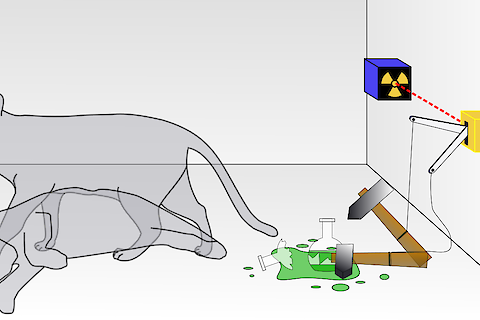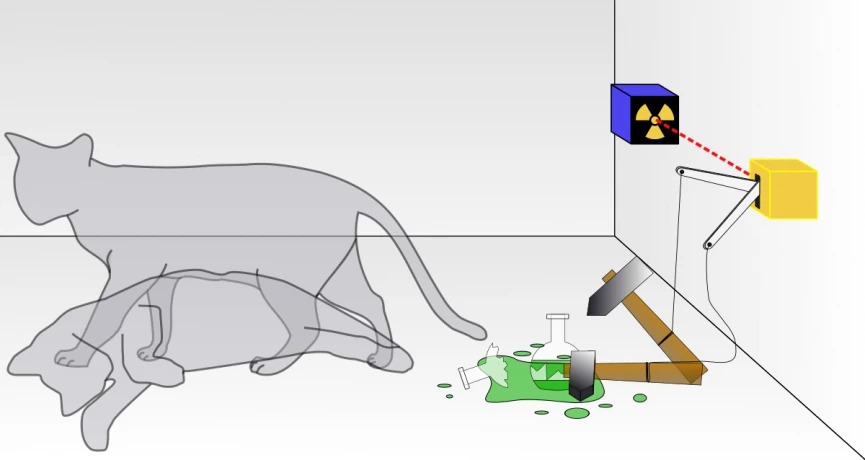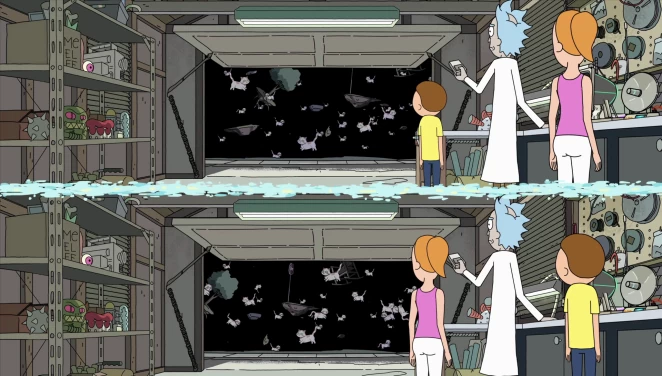

Often referred to as Schrödinger's cat paradox, this is a popular thought experiment created by Austrian physicist Erwin Schrödinger in 1935. It gets a bit complicated here looking at interpretations of quantum mechanics and I am no physicist nor will ever be so we aren’t really going to get into the thick of it, but more the possibilities that it represents. The thought process is quite interesting and is something I feel we could apply to the way we look at the paranormal.
What is Schrödinger's Cat paradox?
The scenario this paradox presents is a hypothetical cat. The thought experiment implies that the cat may be either dead or alive all at the same time. A cat is placed in a sealed box along with a radioactive sample, a Geiger counter (which detects radiation) and a bottle of poison. If the Geiger counter detects this radioactive sample which is inside the box, it triggers something that releases the poison from the bottle and the cat would die. This thought experiment was devised as a way to illustrate the flaws of what is called the ‘Copenhagen interpretation’ of quantum mechanics. This states that a particle exists in all states at once until it is observed. So this essentially means that the cat can be alive and dead at the same time until someone opens the box to observe the cat.
One can even set up quite ridiculous cases. A cat is locked up in a steel chamber, along with the following device (which must be secured against direct interference by the cat): in a Geiger counter, there is a tiny bit of radioactivesubstance, so small, that perhaps in the course of the hour one of the atoms decays, but also, with equal probability, perhaps none; if it happens, the counter tube discharges and through a relay releases a hammer that shatters a small flask of hydrocyanic acid. If one has left this entire system to itself for an hour, one would say that the cat still lives if meanwhile no atom has decayed. The psi-function of the entire system would express this by having in it the living and dead cat (pardon the expression) mixed or smeared out in equal parts.
It is typical of these cases that an indeterminacy originally restricted to the atomic domain becomes transformed into macroscopic indeterminacy, which can then be resolved by direct observation. That prevents us from so naively accepting as valid a "blurred model" for representing reality. In itself, it would not embody anything unclear or contradictory. There is a difference between a shaky or out-of-focus photograph and a snapshot of clouds and fog banks.
— Erwin Schrödinger, Die gegenwärtige Situation in der Quantenmechanik (The present situation in quantum mechanics), Naturwissenschaften
(translated by John D. Trimmer in Proceedings of the American Philosophical Society)

Our common sense of course tells us that the cat is either dead or alive – it can’t be both whether or not we have observed it’s state or not........ or can it?
Is this a case for multiple realities?
In the 1950s, there was a many worlds interpretation of quantum mechanics that emerged. When applying it to Schrödinger's Cat paradox, it claimed that the observer and the dead/alive cat split into two different realities. One reality where the observer sees the cat as dead, and another where it sees it alive. Based on this, the hypothesis says that there could potentially be an infinite number of universes which consist of everything that could have possibly happened in our past but didn’t. The best way to describe this is from the movie sliding doors. When the main character caught her train on time, she went home to find her partner cheating on her. In another reality she missed her train and it set her upon a completely different path. Think of all the different scenarios in your life. You could have gone to work but you called in sick. In another universe, you went to work and so on.
Applying Schrödinger's Cat to the paranormal
The point with this thought experiment is ‘observation’ and you know me, I am always using this word when it comes to the paranormal. In popular culture, Schrodinger’s Cat is used to argue many points. From a person potentially being guilty and not guilty in a court case through to an episode of Rick and Morty which in some ways has a pretty cool subtext. It is here that I must state that I cannot stand Rick and Morty, and people can’t seem to believe that I find this show anything but genius but no I do not like it yet forced to watch it endlessly with my husband. Anyway in an episode called A Rickle in Time. In the episode, Rick, Morty, and his sister Summer (having restarted time after freezing it in the season one finale "Ricksy Business") are in a quantum-uncertain state of existence. An argument leads to the creation of two alternate timelines, which need to be stitched back together fast if they are to escape quantum collapse. In this uncertain state are floating Schrodinger’s cats which of course is a bit of a joke but makes a point. Due to uncertainty of being able to make decisions, the characters were simultaneously living in 64 different timelines with all of the different possibilities.

Something that is dead and alive at the same time again we know is not practical but for some reason, it is logical according to quantum mechanics. It begs to ask the question, where can this possibly exist? The answer is outside of what we believe is a concept of time. When we apply this to the paranormal and in particular the way we look at spirits, mainstream belief is that we are communicating with the spirit of a person who has passed away and that their consciousness has remained or imprinted on it's surroundings in some way. What if these ghosts, are really just us picking up on these simultaneous timelines?.
“One way to think about it is that they coexist in the same space as our universe, like ghost universes,”Howard Wiseman Griffith University Queensland
Time may not be the same in an alternate time line. An hour in our timeline could potentially be years in another timeline. Is this why when we communicate with said phenomena we get answers alluding to the past?
There is really only one way to find out
If I was going to put things really simply, this paradox also explains a very simple point when it comes to scientific theory. No one knows if any scientific theory is right or wrong until it can be tested and proven.
In the same way that people can tell us that ghosts etc do not exist, while we have yet to scientifically prove this, can it be proven that they do not exist? In the thought experiment, we actually don’t know the answer until we open the box to see if the cat is alive or dead. We aren’t going to get any of these answers by sitting and just talking about it. We need to go out there and open the box and see what is inside. The answers may surprise us all!
If you enjoy LLIFS, consider buying me a book (otherwise known as buy me a coffee but I don't drink coffee and I LOVE books). Your donation helps to fund the LLIFS website so everyone can continue to access great paranormal content and resources for FREE!

Top pages with similar subjects
Don't forget to follow the Facebook page for regular updates
Join the mailing list to receive weekly updates of NEW articles. Never miss an article again!
Buy the latest and past issues Haunted Magazine
Check out the books written by LLIFS